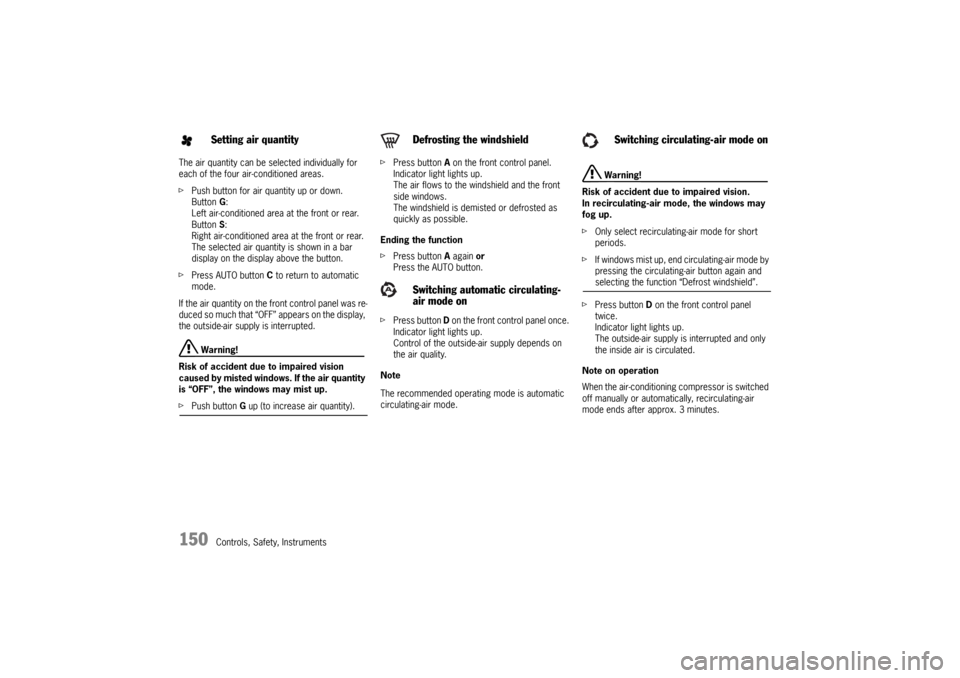ECO mode PORSCHE CAYNNE TURBO 2006 1.G User Guide
[x] Cancel search | Manufacturer: PORSCHE, Model Year: 2006, Model line: CAYENNE TURBO, Model: PORSCHE CAYENNE TURBO 2006 1.GPages: 387, PDF Size: 8.44 MB
Page 149 of 387

Controls, Safety, Instruments
149
You can switch to automatic mode for the front
and rear air-conditioned areas, independently of
one another.
fPress AUTO button C on the front or rear
control panel.
The indicator light in button C of the front con-
trol panel and the Auto indication in the rear
control panel are lit.
Air quantity and distribution are automatically
controlled and variations are compensated.
Note on operation
If necessary, the automatic system can be
manually influenced.
This setting is retained until the appropriate
function button is pressed again or the AUTO
button C is pressed.Switching MONO function on
The temperature and air quantity settings for the
driver’s side can be accepted for the entire
vehicle.
fPress AUTO button C in the front control panel
for 2 seconds.
The MONO logo appears on the air-condi-
tioning display panel.
Ending MONO function
fPress AUTO button C in the front control panel
for 2 seconds or
fChange the settings in the air-conditioned
areas.
Setting temperatureTo suit personal comfort, the interior temperature
for each of the four air-conditioned areas can be
adjusted between 61°F and 85°F (16°C and
29.5°C).
Recommendation: 72°F (22°C)
fPush temperature button up or down.
Button H:
Left air-conditioned area at the front or rear.
Button R:
Right air-conditioned area at the front or rear.
The selected temperature is shown on the
display above the button.
If “LO” or “HI” appears on the display, the system
is operating at maximum cooling or heating pow-
er.
If the preselected temperature is changed, the air
quantity blowing out can adjust automatically in au-
tomatic mode.
The desired temperature is reached more quickly
this way.
Automatic mode
Page 150 of 387

150
Controls, Safety, Instruments The air quantity can be selected individually for
each of the four air-conditioned areas.
fPush button for air quantity up or down.
Button G:
Left air-conditioned area at the front or rear.
Button S:
Right air-conditioned area at the front or rear.
The selected air quantity is shown in a bar
display on the display above the button.
fPress AUTO button C to return to automatic
mode.
If the air quantity on the front control panel was re-
duced so much that “OFF” appears on the display,
the outside-air supply is interrupted.
Warning!
Risk of accident due to impaired vision
caused by misted windows. If the air quantity
is “OFF”, the windows may mist up.
fPush button G up (to increase air quantity).fPress button A on the front control panel.
Indicator light lights up.
The air flows to the windshield and the front
side windows.
The windshield is demisted or defrosted as
quickly as possible.
Ending the function
fPress button A again or
Press the AUTO button.
fPress button D on the front control panel once.
Indicator light lights up.
Control of the outside-air supply depends on
the air quality.
Note
The recommended operating mode is automatic
circulating-air mode.
Warning!
Risk of accident due to impaired vision.
In recirculating-air mode, the windows may
fog up.
fOnly select recirculating-air mode for short
periods.
fIf windows mist up, end circulating-air mode by
pressing the circulating-air button again and selecting the function “Defrost windshield”.
fPress button D on the front control panel
twice.
Indicator light lights up.
The outside-air supply is interrupted and only
the inside air is circulated.
Note on operation
When the air-conditioning compressor is switched
off manually or automatically, recirculating-air
mode ends after approx. 3 minutes.
Setting air quantity
Defrosting the windshield
Switching automatic circulating-
air mode on
Switching circulating-air mode on
Page 151 of 387

Controls, Safety, Instruments
151
The air quantity can be selected individually for
each of the four air-conditioned areas.
– Front control panel:
The air flows to the windscreen.
– Rear control panel:
The air flows to the respective side window.
fPress button I or O.
fPress button K or P.
– Front control panel:
The air flows from the front central and side
vents.
– Rear control panel:
The air flows to the center vents.
fVents must be open.
fPress button L or Q.
The air flows to the footwell.
Ending air distribution functions
fPress the relevant button again or
fPress the AUTO button.
ECON modeThe outside air that is flowing in does not dry up if
the air-conditioning compressor is switched off.
Warning!
Risk of accident due to hampered vision.
If the air-conditioning compressor is
switched off, the windows may mist up.
fDo not switch off the air-conditioning compres-sor in damp weather.
Switching air-conditioning compressor off
Whenever outside temperatures exceed 37.4°F
(3°C), the air-conditioning compressor is always
switched on in automatic mode.
The compressor can be switched off to save fuel,
but control comfort is then limited:
fPress ECON button N on the front control
panel. The air-conditioning compressor is
switched off.
Switching air-conditioning compressor on
fIf the interior temperature is too high:
Press ECON button N or
Press AUTO button C.
Information on air-conditioning
compressorThe air-conditioning compressor:
– Can switch off briefly if engine is under an ex-
treme load to ensure sufficient engine cooling.
– Switches off automatically at temperatures be-
low approx. 37.4°F (3°C) and cannot be
switched on, even manually.
– Operates most effectively with windows
closed.
If the car has been in the sun for a long time,
however, it is a good idea to ventilate the inte-
rior briefly with the windows open.
Notes on operation
Depending on the outside temperature and humid-
ity, condensation can drip from the evaporator
and form a pool under the car.
This is normal and not a sign of leakage.
If uncooled air flows out when the lowest temper-
ature has been set (“LO”), switch off the air-condi-
tioning compressor and have the fault remedied at
an authorized Porsche dealer.
Air to windshield
Air to central and side vents
Air to footwell
Page 152 of 387

152
Controls, Safety, Instruments Using engine residual heat
The residual heat of the engine can be used to
heat the interior up to 20minutes after the ignition
has been switched off.
fPress AUTO/REST button C on the front
control panel.
The air-conditioning settings cannot be
changed in REST mode.
Ending the function
fPress AUTO/REST button C.
Note on operation
If the battery positive voltage is too low, REST
mode is automatically ended.
fPlease observe the chapter “WARNING LIGHTS
AND WARNING MESSAGES” on Page 122.fPress button M.
Symbol appears on the display.
The rear air-conditioned areas can be control-
led from the front control panel.
Ending the function
fPress button M again.
Note on operation
The function is ended automatically 10 seconds
after the last settings are made.REST mode
Controlling rear air-conditioned
areas with the front control panel
Page 216 of 387

216
Shifting Gear, Traction Systems
D - Automatic selection mode (in the road
driving program)The functions of selector lever positions D and M
differ in the on-road program, High Range, and in
the off-road program, Low Range.
fUse selector lever position D for “normal” driv-
ing.
The gears are shifted automatically according
to the accelerator position and speed.
Depending on the way the vehicle is driven and on
the resistance (e.g. uphill), the gear-changing
points are shifted towards higher or lower engine-
speed ranges. Movement of the accelerator,
driving speed, longitudinal and lateral acceleration
and the road profile all have an influence on the
gear-changing characteristic.
When PSM is switched off, transmission gear
changes are done at higher engine speeds.
Unwanted upward shifts, e.g. before corners, are
prevented by swiftly releasing the accelerator ped-
al.
Depending on lateral acceleration, upward chang-
es on corners are not made until the engine-speed
limit is reached.
During braking, and depending on the amount of
deceleration, the Tiptronic changes down earlier.
For subsequent cornering, the right gear is en-
gaged when pressure is applied to the brakes be-
fore the corner.The corner is taken in the right gear, and when you
accelerate out of the corner you do not have to
change down.
Moving off
In 2nd gear, the vehicle moves off with the throttle
only slightly open. Move off in 1st gear with the
throttle open wider or when the engine is cold.
When PSM is switched off, the car generally
moves off in 1st gear.
Shifting gear on the steering wheel
By shifting gear with the rocker switches on the
steering wheel, you can temporarily change from
automatic selection mode D to manual selection
mode M.
Advantages
– Shifting down before corners and on entering
built-up areas.
– Shifting down on downward slopes (engine
braking).
– Shifting down for brief spurts of acceleration.
– Selecting 1st or 2nd gear for moving off.
The manual selection mode remains engaged:
– For cornering (depending on the lateral accel-
eration) and overrunning,
– When the vehicle is stationary (e.g. at a junc-
tion).The system leaves manual selection mode:
– automatically after around 8 seconds
(unless car is cornering, overrunning or
stationary),
– if you depress the accelerator to kickdown.
Temporary change-down
Precondition
– Speed is higher than approx. 33 mph
(54 km/h).
fDepress accelerator quickly.
The Tiptronic changes temporarily to the sport-
iest gear-changing map, i.e. to the highest pos-
sible gear-changing points. Correspondingly,
the transmission shifts down immediately by
one, two or three gears.
Ending the function
fRelease the accelerator markedly (by approx.
25%).
Page 217 of 387

Shifting Gear, Traction Systems
217
Kickdown
The kickdown function is active in selector lever
position D.
fFor optimum acceleration, e.g. when overtak-
ing, depress the accelerator pedal beyond the
full-throttle point (kickdown).
The transmission shifts down depending on the
speed of travel and engine speed.
Upward shifts occur at the highest possible engine
speeds.
These gear-changing speeds remain active until
the accelerator is released to approx. 80% of the
full-throttle position.D - Automatic selection mode (in the off-
road driving program)The functions of selector lever positions D and M
differ in the on-road program, High Range, and in
the off-road program, Low Range.
fUse selector lever position D for “normal” driv-
ing.
The gears are shifted automatically according
to the accelerator position and speed.
The gears are shifted automatically according to
the accelerator position and speed. The gear-
changing points have been adjusted to achieve the
best possible vehicle control on difficult terrain.Depending on the route profile, the gear-changing
points are shifted towards higher or lower engine-
speed ranges. On steep downhill stretches, up-
ward shifts are prevented until medium engine
speeds are reached (at least 2,500 rpm).
When the car is overrunning, an automatic upshift
does not occur when the engine speed limit is
reached.
Moving off
The car moves off in 1st gear.
Shifting gear on the steering wheel
By shifting gear with the rocker switches on the
steering wheel, you can temporarily change from
automatic selection mode D to manual selection
mode M.
Advantages
– Shifting down on downward slopes (engine
braking).
– Shifting down for brief spurts of acceleration.
– Selecting 1st/2nd or 3rd gear for moving off.
The manual selection mode remains engaged:
– For overrunning
– Depending on lateral acceleration
– When the vehicle is stationary (e.g. at a junc-
tion).The system leaves manual selection mode:
– Automatically after around 8 seconds
(unless car is subject to high lateral accelera-
tion, is overrunning or stationary),
– if you depress the accelerator to kickdown.
Kickdown
The kickdown function is active in selector lever
position D.
fFor optimum acceleration, e.g. when overtak-
ing, depress the accelerator pedal beyond the
full-throttle point (kickdown).
The transmission shifts down depending on the
speed of travel and engine speed.
Upward shifts occur at the highest possible engine
speeds.
These gear-changing speeds remain active until
the accelerator is released to approx. 80% of the
full-throttle position.
Tip on driving
Unlike in the on-road driving program, an auto-
matic upshift is not performed in manual selection
mode M when the engine-speed limit is reached.
Page 229 of 387

Shifting Gear, Traction Systems
229
Full-time all-wheel drive
With the four-wheel drive, the drive power is varia-
bly distributed to the front and rear wheels.
Power distribution and wheel speed compensation
between the front and rear axles is realised with a
transfer box.
Distribution of the drive power depends on the
wheel speed difference between the two axles.
The transfer box always controls power distribu-
tion in such a way that optimal propulsion is
achieved, even on an unfavorable road surface.
Full-time four-wheel drive ensures optimal handling
and great stability.
Warning!
In spite of the advantages of four-wheel drive, it is
still the driver’s responsibility to adapt his driving
style and maneuvers in line with road and weather
conditions, as well as the traffic situation.
The increased safety that is provided should not in-
duce you to take greater risks with your safety.
The limits set by the physics of driving cannot be
overcome, even with four-wheel drive.
Risks of accident due to inappropriate speed can-
not be reduced by four-wheel drive.Automatic brake differential (ABD)
The ABD system controls the front and rear axles
separately. If one wheel of an axle starts to spin,
it is braked so that the other wheel on the same
axle can be driven.
The ABD recognises different driving states, and it
features control strategies adapted to these
states. In situations in which little propulsive power
is required, such as when the car moves off on a
level gravel surface, traction control already be-
comes active at low engine speeds. If great
propulsive power is required, e.g. when moving off
on an uphill slope or for rapid acceleration, the
ABD is adapted accordingly.
A special off-road program is used in Low Range
mode.Traction control system (TCS)
The traction control system prevents the wheels
from spinning by adjusting the engine power,
thereby ensuring good lane-holding ability and a
stable driving behavior.
Page 243 of 387

Shifting Gear, Traction Systems
243
Driving on sandNote on operation
fActivate Low Range and engage differential
locks if necessary.
Tips on driving
Loose sand is an especially tricky surface for off-
road driving.
You can often become stuck in sand within
minutes if you do not drive correctly in such
situations.
fDrive at brisk pace and do not stop under any
circumstances. This will reduce the chance of
the car becoming bogged down.
fFollow existing tracks – provided that they
have not been covered by blown sand, are not
too deep and the car's ground clearance is
sufficient.
Please observe the chapter “GROUND CLEA-
RANCE” on Page 375.
fAvoid high engine speeds (may. 2,500 rpm).When driving on slopes with soft sand:
fUse the manual select mode M in addition to
the Low Range program.
If your vehicle becomes stuck nevertheless:
fDo not spin the wheels. Instead, use branches,
mats or similar items to provide adequate trac-
tion so that you can drive out of the critical ar-
ea.
Track rutsOther vehicles leave ruts in many off-road courses
or gravel roads.
fPlease observe the chapter “GROUND CLEA-
RANCE” on Page 375.
Caution!
Risk of damage to the vehicle floor when
driving through ruts that are too deep.
fAlways bear in mind the car's ground clear-
ance.
fDo not drive over ruts that are too deep.
Note on operation
fActivate Low Range and engage differential
locks if necessary.
Tips on driving
fIn cases of doubt, drive with one wheel on the
strip of grass between the ruts.
fAvoid high engine speeds (max. 2,500 rpm).
fDrive slowly.
Page 292 of 387

292
Practical Tips, Minor Repairs
Tire replacementsfUse only tire makes and types tested by
Porsche.
Only tires with the same manufacturer and
with the same specification code (e.g. “N0“,
“N1“...) should be mounted on the vehicle.
Tires should be replaced no less than on one axle
at the time. Only tires of the same make and type
must be used. Mixed tires are not permissible and
will affect vehicle performance, safety, and can
affect vehicle warranty.
Porsche dealers can recommend the most current
replacement tire options for your vehicle.
Initially, new tires do not have their full traction.
You should therefore drive at moderate speeds
during the first 60 - 120 miles (100 - 200 km).Tires should be replaced no less than on one axle
at the time. Only tires of the same make and type
must be used. Mixed tires are not permissible.
Initially, new tires do not have their full traction.
You should therefore drive at moderate speeds
during the first 60 - 120 miles (100 - 200 km).
If new tires are installed only on one axle, a notice-
able change in handling occurs due to the different
tread depth of the other tires. This happens espe-
cially if only rear tires are replaced. However, this
condition disappears as the new tires are broken
in.
fPlease adjust your driving style accordingly.
Installation of new tires should only be done by a
qualified tire technician.
Valves
fUse only plastic valve caps.
fThe rubber valves must be replaced whenever
the tires are changed.
fThe fitting and replacement specifications
must be observed for metal valves.
fOnly use Original Porsche metal valves.
fProtect the valve inserts against soiling with
valve caps.
Soiled valve inserts can cause a gradual loss
of air.
Page 295 of 387

Practical Tips, Minor Repairs
295
Snow tiresThe installation of Porsche approved winter tires is
recommended.
Use Porsche approved winter tires for grip on
snow and ice. For optimum performance, stud-
ding can be considered.
Check with your local Motor Vehicle Bureau for
possible restrictions.
Danger!
Risk of loss of control and damage to the
vehicle as well as serious personal injury or
death.
The standard tires profile and rubber mixture
are optimized for wet and dry driving condi-
tions, and may not prove favorable for snow
conditions.
fInstall winter tires before driving in such condi-tions.
Before mounting winter tires, consult with your
Porsche dealer. He has the technical information
necessary to advise you on wheel and tire compat-
ibility.
Snow tires should have the same load capacity as
original equipment tires and should be mounted on
all four wheels.
Winter tires with studs should be run at moderate
speeds when new in order to give the studs time
to settle.
Danger!
Risk of serious personal injury or death.
Driving the vehicle with low tire pressure
increases increases risk of a tire failure and
resulting loss of control. Furthermore, low
tire pressure increases rate of wear of the
affected tires and cause damage.
Tires with badly worn treads and studs are
very dangerous and could cause accidents
resulting in serious personal injuries or
death.
fMake sure they are replaced immediately.
fDo not exceed the winter tire speed rating.
Snow tires do not have the same degree of trac-
tion on dry, wet or snowfree roads as normal tires.
Furthermore, snow tires wear rapidly under these
conditions.
Winter tires do not fulfill their purpose if the tread
depth is less than 5/32 in. (4 mm).
Comply with all state and local laws govern-
ing snow tire and tread depth requirements.
Danger!
Risk of accident and serious personal injury
or death due to excessive speed.
fAlways check the maximum speed rating on
the tire sidewall on any tire on the vehicle.
fNever exceed the maximum speed rating of the tires.
Wheel change
fWhen wheels are removed, mark the direction
of rotation and position of each wheel.
Example: FR (front right), FL, RR and RL.
fAlways fit the wheels in accordance with the
markings.